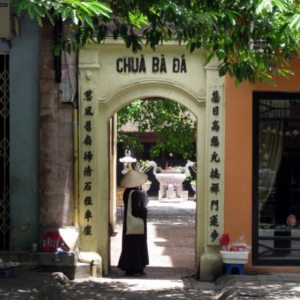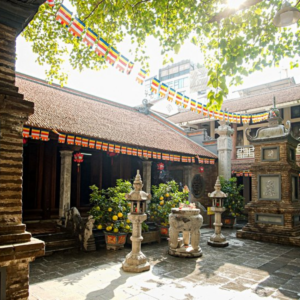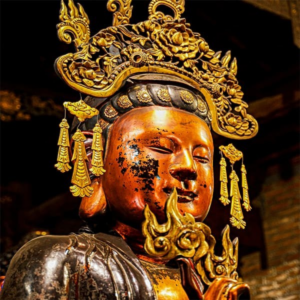Ba Da Pagoda – A Peaceful Spiritual Escape in the Heart of Hanoi
How to Visit Ba Da Pagoda – Hanoi’s Hidden Spiritual Treasure
Nestled just steps away from Hanoi’s bustling streets, Ba Da Pagoda (Chua Ba Da) is a peaceful spiritual site that many locals turn to for calm and blessings. Although small and humble in appearance, the temple holds deep historical and cultural value, making it a perfect stop for anyone seeking a quiet moment in their Hanoi journey.
About Ba Da Pagoda

Ba Da Pagoda, also known in Vietnamese as Chua Ba Da, is a small but historically rich Buddhist temple located in the heart of Hanoi’s Old Quarter. Its official name is Linh Quang Tu, which means “Temple of Sacred Light.” The pagoda was originally built in the 11th century and has been restored several times over the centuries. Its nickname, “Ba Da” or “Lady of Stone,” comes from a local legend where a sacred stone statue of a female Buddha was found on the site, believed by locals to be a divine sign.
Despite its modest size, Ba Da Pagoda holds significant spiritual value and once served as the headquarters of the Buddhist Association of Northern Vietnam. Today, it remains a quiet place of worship where locals come to pray for peace, health, and happiness — offering visitors a meaningful glimpse into the spiritual life of Hanoians.
Location & How to Get There
Location:
Ba Da Pagoda is located at No. 3 Nha Tho Street, Hoan Kiem District, Hanoi, just a short walk from many of Hanoi’s most famous landmarks. It sits quietly behind the bustling St. Joseph’s Cathedral, making it easy to miss unless you’re looking for it.
How to Get There:
– On Foot: Only a 2-minute walk from St. Joseph’s Cathedral and about 5 minutes from Hoan Kiem Lake, perfect for those exploring the Old Quarter.
– By Taxi or Grab: Simply enter “Chua Ba Da” or “Ba Da Pagoda” in your ride-hailing app. The temple is centrally located and easy to access from anywhere in Hanoi.
– By Bus: You can take buses that stop near Trang Thi Street or Ba Trieu Street, then walk about 5–10 minutes.
– By Bicycle or Motorbike: There’s limited parking nearby, but you can easily stop at surrounding cafés or shops and walk in.
Tip: Look for the small alleyway to the left of the Cathedral’s main entrance — the pagoda is tucked behind residential buildings, creating a hidden, peaceful vibe amid the urban hustle.
What to See and Experience at Ba Da Pagoda
- Traditional Vietnamese Buddhist Architecture
The pagoda features typical Northern Vietnamese design with curved tiled roofs, carved wooden beams, and antique altars. Despite being located in a narrow alley, it’s beautifully preserved, offering a tranquil and sacred space for worship. Inside, you’ll find:
- Altars dedicated to Buddha, Avalokiteshvara (Goddess of Mercy), and other deities.
- Ancient hoanh phi (horizontal boards) and câu đối (parallel scrolls) with calligraphy offering teachings of compassion and mindfulness.
- Incense burners and floral offerings that reflect active worship by the local community
- A Peaceful Spiritual Atmosphere
The moment you step into the pagoda, the noise of the outside world fades away. You’re greeted by the soft scent of incense and the gentle sound of prayers or monks chanting. It’s a perfect space to:
- Meditate or reflect quietly
- Observe locals making offerings or praying
- Absorb the calming energy that fills the space
Even if you’re not religious, you’ll feel a deep sense of peace and respect here.
- The Legend of the Stone Lady (Ba Da)
The temple’s unique nickname comes from a legend that a stone statue of a female Buddha appeared on the grounds centuries ago, considered a sacred sign by the community. This mystical origin gave the pagoda its popular name: “Ba Da” – Lady of Stone.
This story is a beautiful example of how Vietnamese folklore and Buddhism intertwine, giving deeper meaning to the spaces people worship in.
- Daily Worship and Special Occasions
Ba Da Pagoda is a living place of worship, not just a historical site. You might witness:
- Locals lighting incense early in the morning or before work
- Elderly residents chanting sutras or reading Buddhist texts
- Special decorations and rituals during festivals like Buddha’s Birthday or Vu Lan (Ancestor’s Day)

How to Visit Ba Da Pagoda Respectfully
- Dress Modestly
Wear clothing that covers your shoulders and knees. Avoid shorts, tank tops, or revealing outfits. If possible, bring a light scarf or jacket to cover up when entering the inner worship areas.
- Keep Your Voice Down
The pagoda is a place of prayer and meditation. Speak softly, or remain silent—especially inside the main hall—so as not to disturb others who are praying or reflecting.
- Be Mindful with Photography
Photography is allowed in some areas, but avoid taking photos at the altars or of people who are worshipping unless you have their permission. Always ask the caretakers if you’re unsure.
- Show Respect at the Altar
If you’d like to offer incense:
- Take only one or three sticks, light them, and gently bow.
- Don’t stick them in randomly—follow the example of locals.
- You don’t have to be Buddhist to participate—a respectful heart is what matters most.
- Keep the Space Clean
Don’t litter, eat, or smoke on the premises. The pagoda is kept very clean and orderly—please help maintain that peaceful environment.
- Follow the Locals’ Lead
Observe how others behave—when to take off your shoes, how they bow, or what spaces are considered private. Locals are usually kind and happy to guide you if you’re respectful and curious.
Combine with Nearby Attractions
- St. Joseph’s Cathedral (2-minute walk)
Just around the corner from Ba Da Pagoda is the iconic St. Joseph’s Cathedral, a Gothic Revival church built in the late 19th century.
- Admire its beautiful architecture and stained-glass windows
- Visit during service hours for a glimpse of local Catholic culture
- Take photos in the charming square often filled with young locals and travelers
- Hoan Kiem Lake & Ngoc Son Temple (5–7-minute walk)
A short stroll brings you to Hoan Kiem Lake, the heart of Hanoi.
- Walk around the lake for fresh air and scenic views
- Cross the iconic red The Huc Bridge to explore Ngoc Son Temple
- Learn about the legend of the giant golden turtle and magical sword
- Old Quarter Streets (5–10-minute walk)
Wander through Hang Trong, Hang Gai, and Luong Van Can streets for:
- Traditional handicrafts and souvenirs
- Local art galleries and silk shops
- Bustling scenes of Hanoi’s daily life
- Enjoy a Vietnamese Coffee Break
Right on Nha Tho Street, you’ll find cozy cafés with views of the Cathedral:
- Try egg coffee or coconut coffee, Hanoi’s signature drinks
- Great places for people-watching or journaling after temple visits
- Thang Long Water Puppet Theater (10-minute walk)
End your cultural route with a visit to this unique traditional Vietnamese art form.
- Shows start daily in the late afternoon and evening
- Great for all ages and available in English
- Book in advance during weekends or holidays

Conclusion
Ba Da Pagoda may be small in size, but it holds a deep spiritual and historical presence right in the heart of Hanoi. With its peaceful atmosphere, rich Buddhist heritage, and traditional Vietnamese architecture, this sacred tourism site offers travelers a moment of calm and reflection away from the hustle of the Old Quarter.
Craving a peaceful break during your Hanoi trip? Add Ba Da Pagoda to your walking itinerary and discover one of the city’s most meaningful hidden gems. Share your Ba Da Pagoda experience with VNITourist – or let us know what surprised you most!

